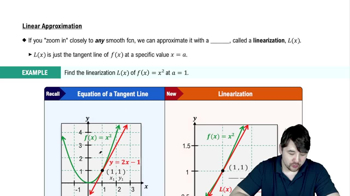Table of contents
- 0. Functions7h 52m
- Introduction to Functions16m
- Piecewise Functions10m
- Properties of Functions9m
- Common Functions1h 8m
- Transformations5m
- Combining Functions27m
- Exponent rules32m
- Exponential Functions28m
- Logarithmic Functions24m
- Properties of Logarithms34m
- Exponential & Logarithmic Equations35m
- Introduction to Trigonometric Functions38m
- Graphs of Trigonometric Functions44m
- Trigonometric Identities47m
- Inverse Trigonometric Functions48m
- 1. Limits and Continuity2h 2m
- 2. Intro to Derivatives1h 33m
- 3. Techniques of Differentiation3h 18m
- 4. Applications of Derivatives2h 38m
- 5. Graphical Applications of Derivatives6h 2m
- 6. Derivatives of Inverse, Exponential, & Logarithmic Functions2h 37m
- 7. Antiderivatives & Indefinite Integrals1h 26m
- 8. Definite Integrals3h 25m
4. Applications of Derivatives
Linearization
Problem 39
Textbook Question
Use linear approximations to estimate the following quantities. Choose a value of a to produce a small error.
√146
 Verified step by step guidance
Verified step by step guidance1
Identify a function that can be approximated, in this case, f(x) = √x.
Choose a value of 'a' that is close to 146 and for which the square root is easy to calculate; a good choice is a = 144, since √144 = 12.
Calculate the derivative of the function f(x) = √x, which is f'(x) = (1/2) * x^(-1/2).
Evaluate the derivative at the chosen point a = 144 to find f'(144).
Use the linear approximation formula: f(x) ≈ f(a) + f'(a)(x - a) to estimate √146 by substituting x = 146 and the values of f(a) and f'(a).
Recommended similar problem, with video answer:
 Verified Solution
Verified SolutionThis video solution was recommended by our tutors as helpful for the problem above
Video duration:
4mPlay a video:
Was this helpful?
Related Videos
Related Practice




